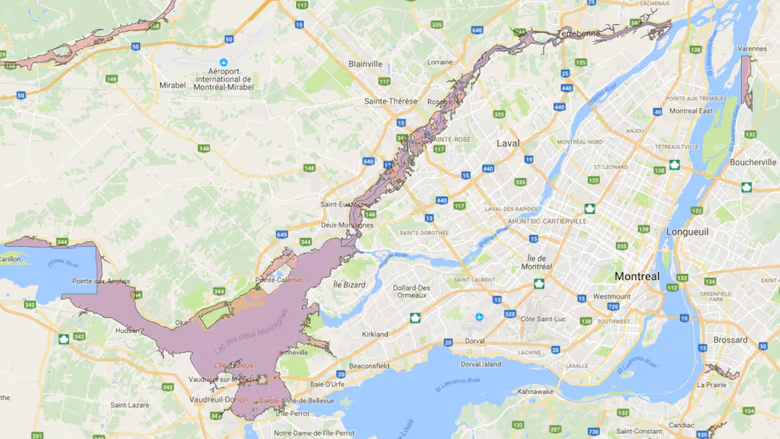What are flood maps, and why are they important?
Used by urban planners and for disaster planning, it's critical to have up-to-date maps. Montreal doesn't

Flood maps are important tools for urban planners, civil security agencies and residents. They help home buyers measure the risk of owning properties on or near waterfront and help insurance companies calculate premiums for those properties.
For all those reasons, it's important to have up-to-date flood maps that take into account climate patterns and changes to land use.
- Montreal flood zone maps for hard-hit Pierrefonds is decades out of date
- Complete coverage of the 2017 Quebec floods
How are flood maps made?
To measure areas that are prone to flooding, complex calculations are made that take into account historical floods, changing river levels and flow rates, as well as the elevation of land.
With these numbers, experts come up with two scenarios:
-
The 20-year flood plain, or zones where there is a five per cent chance of a flood in any given year.
-
The 100-year flood plain, or zones where there is a one per cent chance of a flood in any given year.
Here's the current flood map for Cap-Saint-Jacques and L'Anse-à-l'Orme Nature Park in the West Island. The light red zone is the 20-year flood plain, and the dark red zone is the 100-year flood plain.
Compare it with the actual extent of the recent floods, according to satellite images released by the Quebec government.
Who makes flood maps?
There is no standard for the creation of flood maps in Quebec. In some cases, municipalities may commission their own maps. In other cases, they could be produced by the provincial government.
For the Montreal area, they are made by the Montreal Metropolitan Community (CMM), a council that includes municipalities on the island of Montreal, Laval and on the South and North Shores.
All flood maps in the province are collected and distributed by the Quebec Environment Ministry, which sells the digitized versions for $111.
What kinds of flood maps are available in Montreal?
Montreal's flood maps include very little up-to-date and useful data.
The only maps that are current cover the Lake of Two Mountains and the Mille Îles River between Laval and the North Shore.
Flood information websites for both the City of Montreal and the Quebec government offer printable maps in PDF format for much of the Ottawa and St. Lawrence rivers.
There are no flood maps for most of Montreal's shoreline.

Another city website with flood information contains a map that is so small, it's impossible to see detailed flood plains.
Compare this with public, easy-to-find flood maps for Manhattan and for all of France.
The Quebec government does have archived flood maps for the Rivière des Prairies which the CBC obtained. They were created in the 1980s and taken out of circulation around 2006, when new studies on flood risks were done.
But new maps have not been created for this area with the latest data, which is already 11 years old.
To show how out of date they are, here's how they compare to the actual extent of current flooding at the western tip of Pierrefonds:
Compare this outdated map to the actual flooding on an eastern sector near Saint-Jean Boulevard:
So there are no maps for Pierrefonds. What information is available?
The latest usable data are projections for how high the river would rise in these theoretical 20-year and 100-year zones. But these numbers are just the start; they're one of several ingredients for usable flood maps.
The most recent projection of a flood in the 100-year zone on the Rivière des Prairies predicts it could rise to 24.42 metres. During the highest peak of the flood, on May 8, it rose more than 20 centimetres past that projection.
